ISSN ONLINE(2319-8753)PRINT(2347-6710)
ISSN ONLINE(2319-8753)PRINT(2347-6710)
Panchal Mandar Rajubhai1, Dileep Kumar 2
|
| Related article at Pubmed, Scholar Google |
Visit for more related articles at International Journal of Innovative Research in Science, Engineering and Technology
Solar Photovoltaic systems are the most promising energy resource of the modern world. Performance of Photovoltaic array is directly affected by some parameters like temperature, irradiance, partial shading condition, series resistance and parallel resistance. Analysis of Photovoltaic array characteristics under above circumstances can help to choose most economical/suitable place for Photovoltaic array installation. This paper presents analysis of Photovoltaic array characteristics and concept of using Bypass diode. Physical simulation model of Photovoltaic array is run by programmed m files with the help of MATLAB/SIMULINK. To analyse characteristics of Photovoltaic array and find maximum power point under different temperature levels, different irradiance levels, partial shading condition and different equivalent circuit parameters is the aim of this paper.
Keywords |
| Photovoltaic array; Bypass diode; Characteristics; Simulation. |
INTRODUCTION |
| Conventional energy sources are most reliable energy sources but three major drawbacks of them drive the world towards non-conventional energy sources. First one is conventional energy sources are limited and non-renewable that causes much difference between generated power and demanded power. Second one is these sources are the most pollutant which causes many problems such as global warming, natural disasters. Third one is cost of fossil fuels is high by which operating cost increases [1,2]. |
| Solar energy is inexhaustible and pollution free so it is envisaged as best non-conventional energy resource [3]. Photovoltaic array is used to convert solar energy into electrical energy. A Photovoltaic cell is the basic element in Photovoltaic array. Basically Photovoltaic cell is a semi-conductor device. It acts as a DC source when it is being exposed to sunlight. But single Photovoltaic cell cannot be used practically because it is physically delicate and its output power is low. These drawbacks can be overcome by Photovoltaic module. It is simply interconnections of number of Photovoltaic cells which increases physical strength of Photovoltaic cell by providing a cover to it. Interconnection of number of Photovoltaic Modules is called Photovoltaic Panel and large number of interconnected Photovoltaic panels is known as Photovoltaic array. [4,5]. |
| Modelling of Photovoltaic array maintains interest of researchers for study behaviour of Photovoltaic array under various conditions. Such types of Photovoltaic models are presented in [2], [6] and [7]. Paper [2] presents behaviour of Photovoltaic cell under different irradiance levels, different temperature levels, different values of diode reverse saturation current, different values of series resistance and shunt resistance with help of MATLAB. Paper [6] presents study of Photovoltaic array characteristics under different temperature levels and partial shading condition with help of LT-Spice. While in paper [7] characteristics of Photovoltaic array obtained for different values of irradiance, different values of temperatures and partial shading condition with help of MATLAB. |
| Performance of Photovoltaic array is affected by some factors like temperature, irradiance, partial shading condition and array configuration etc [3,6]. This paper presents analysis of I-V characteristics, P-V characteristics and maximum power point of Photovoltaic array under various conditions like different temperature levels, different irradiance levels, partial shading condition, different values of series resistance and parallel resistance. |
II. EQUIVALENT CIRCUIT OF PHOTOVOLTAIC CELL |
| Basically, Photovoltaic cell is a p-n junction semiconductor. When exposed to the light, it generates DC. The generated current varies linearly with the solar irradiance. The equivalent electrical circuit of an ideal Photovoltaic cell can be treated as a current source parallel with a diode as shown in Fig. 1[8]. |
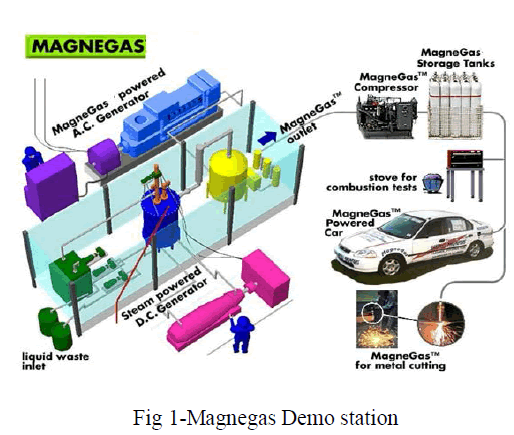 |
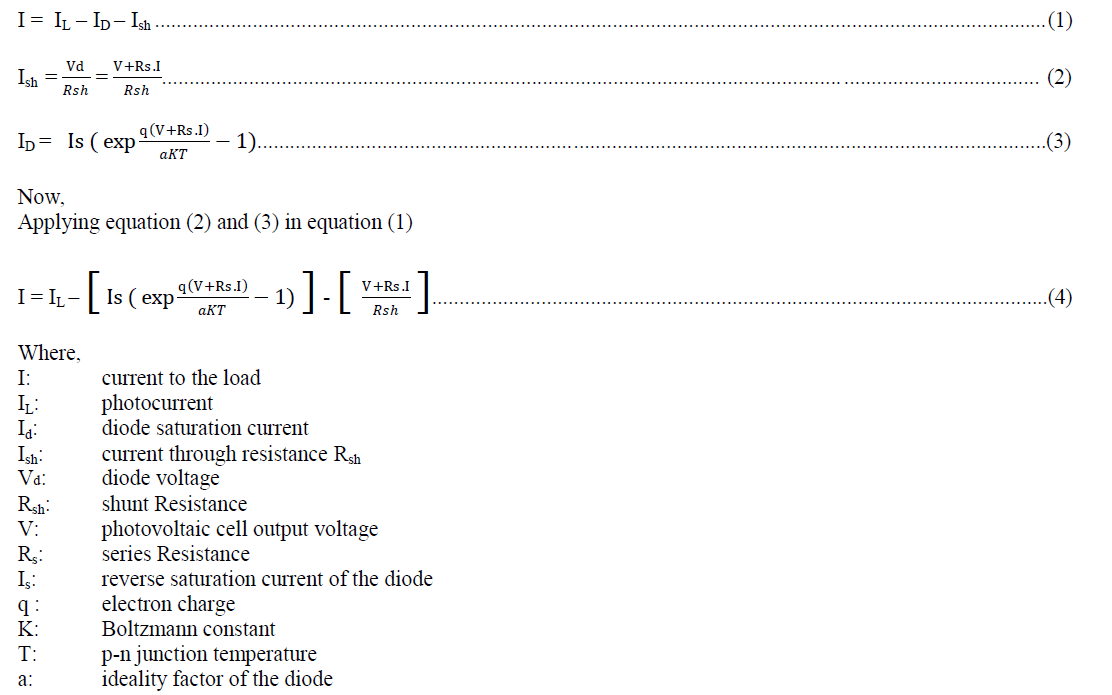 |
III. CHARACTERISTICS OF PHOTOVOLTAIC ARRAY |
| The characteristics of Photovoltaic array, I-V characteristics and P-V characteristics are shown in Fig. 2 and Fig. 3 respectively. In Fig.3 „*âÃâ¬ÃŸ represent maximum power point. These characteristics and maximum power point as represent in Fig.2 and Fig.3 are under normal condition when all parameters are as mentioned in Appendix. |
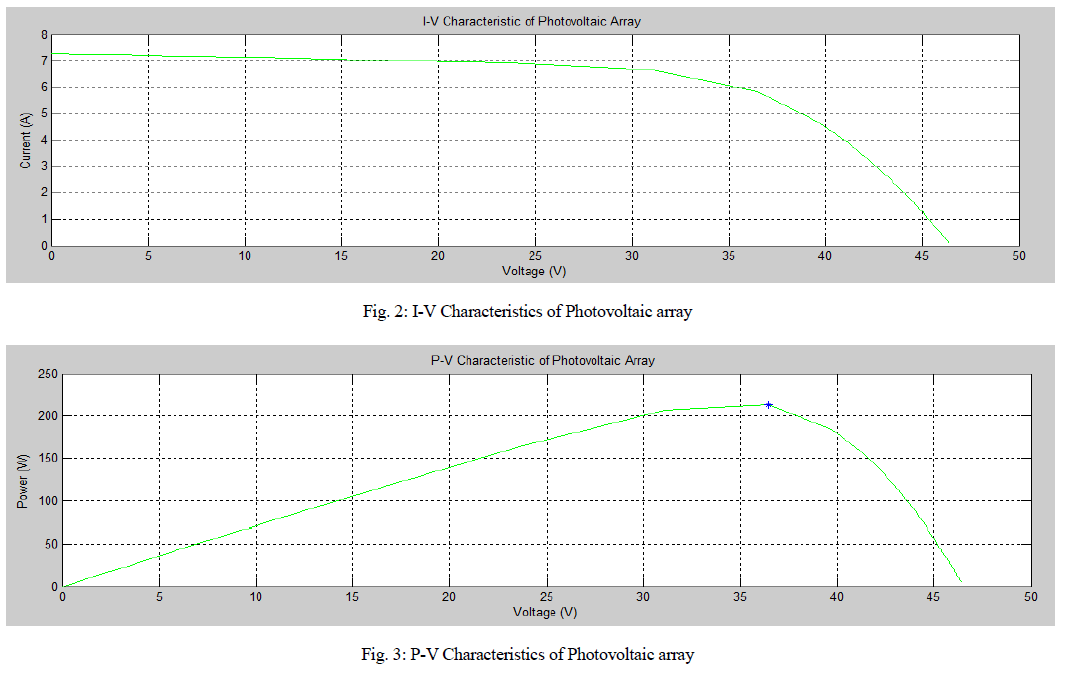 |
IV. PARAMETERS OF PHOTOVOLTAIC CELL |
| Series Resistance Rs: In a practical Photovoltaic cell, there is a series of resistance in a current path through the semiconductor material, the metal grid, contacts, and current collecting bus [7]. The series resistance of the Photovoltaic cell is low and in some cases it can be neglected [2]. |
| Parallel Resistance Rp: This is also called shunt resistance. It is a loss associated with a small leakage of current through a resistive path in parallel with the intrinsic device [7]. The shunt resistance of any Photovoltaic cell should be large enough for higher output power and fill factor. In fact, for a low shunt resistor, the Photovoltaic cell current collapses more steeply which means higher power loss and lower fill factor [2]. |
| Short Circuit Current is the current correspond to the short circuit condition when the impedance is low and it is calculated when the voltage equals to zero [1]. |
| I (at V=0) = Isc....................................................................................................................................................................(5) |
| Open Circuit Voltage is the voltage when the open circuit occurs and there is no current passing through the cell. The Open circuit voltage is calculated when the voltage equals to zero [1]. |
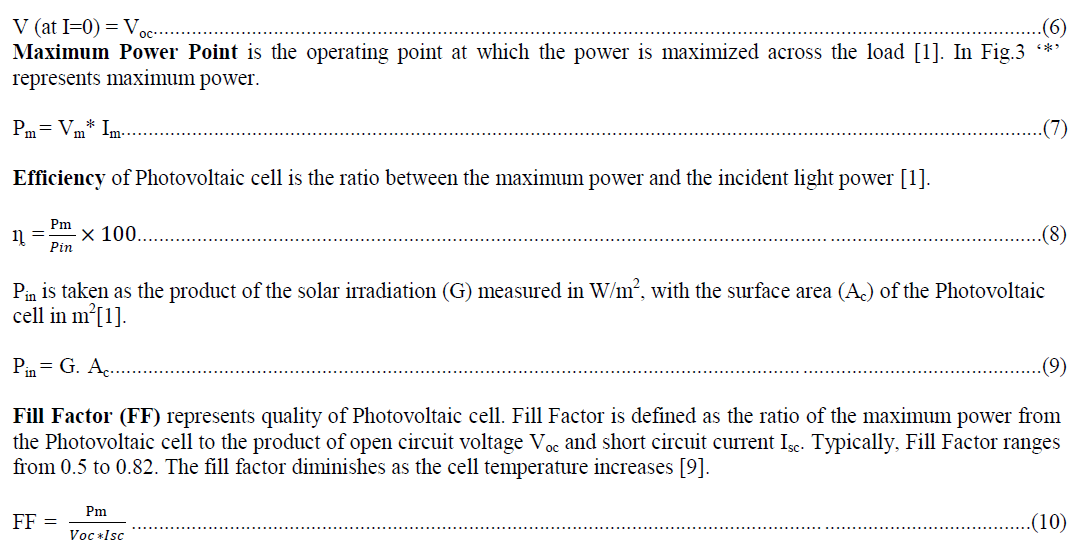 |
V. BYPASS DIODE CONCEPT |
| In uniform shading condition all Photovoltaic modules in Photovoltaic array generate same amount of power. But in partial shading condition, shaded Photovoltaic modules generate less amount of power as compared to other Photovoltaic modules of Photovoltaic array. Due to this mismatch Photovoltaic cells get reverse biased and dissipate power in form of heat [6]. |
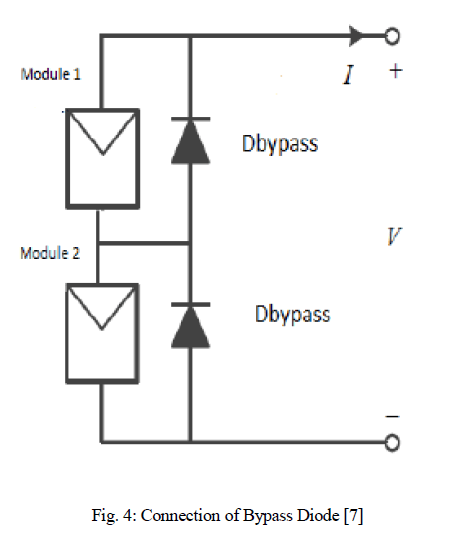 |
| Hence, the shaded cells start consuming instead of generating power as reverse current flows across the shaded cells, thus reducing the generated power output. In order to avoid this, the Bypass diodes are connected in parallel across each Photovoltaic module[6].To stimulate partial shading condition in this simulation model, a small value of constant irradiance signal is fed to two photovoltaic modules while other remaining Photovoltaic array modules are fed by different levels of irradiance signal as mention in Fig. 6. |
VI. SIMULATION MODEL |
| In this system, 6-Photovoltaic cells are connected in series in each Photovoltaic Module. Bypass diodes are connected in parallel across each module. This type of three modules connected in series making Photovoltaic Panel. This type of four panels connected in series in order to make Photovoltaic Array. Finally this Photovoltaic array includes 72 cells connected in series [4].This model is run by programmed m files for analysing characteristics of this Photovoltaic array under various conditions. |
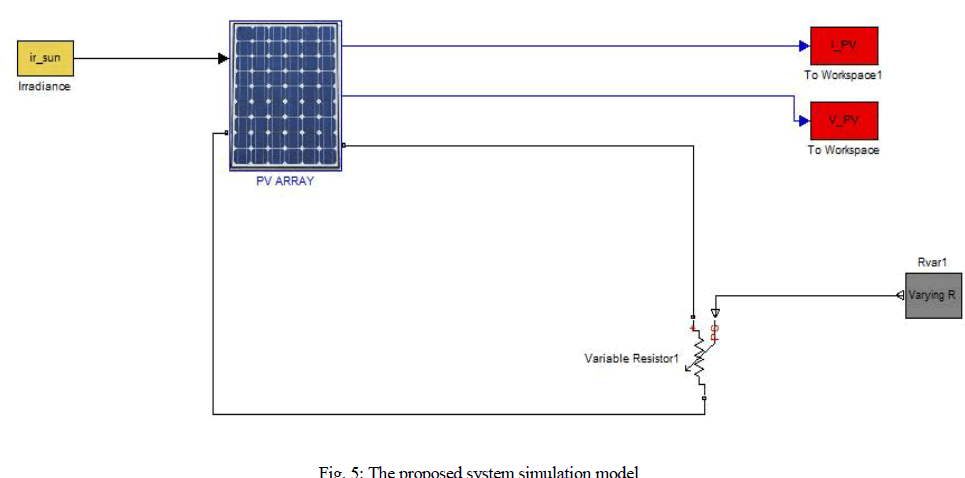 |
VII. SIMULATION RESULTS |
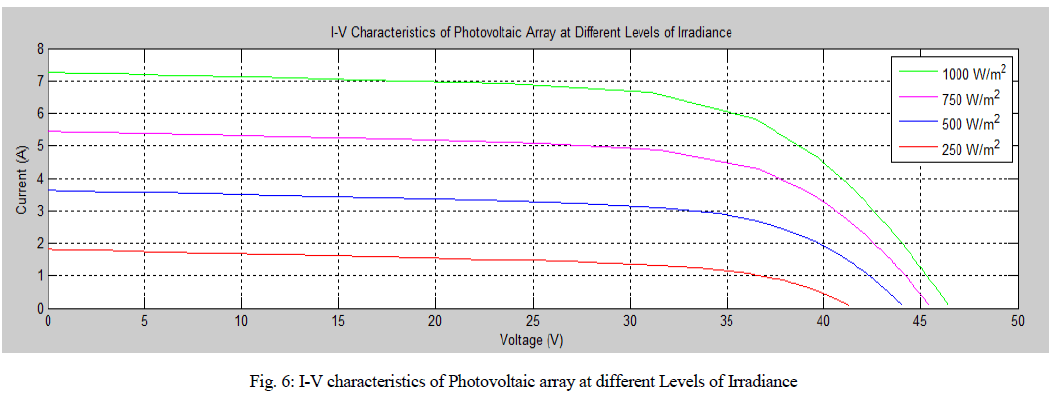 |
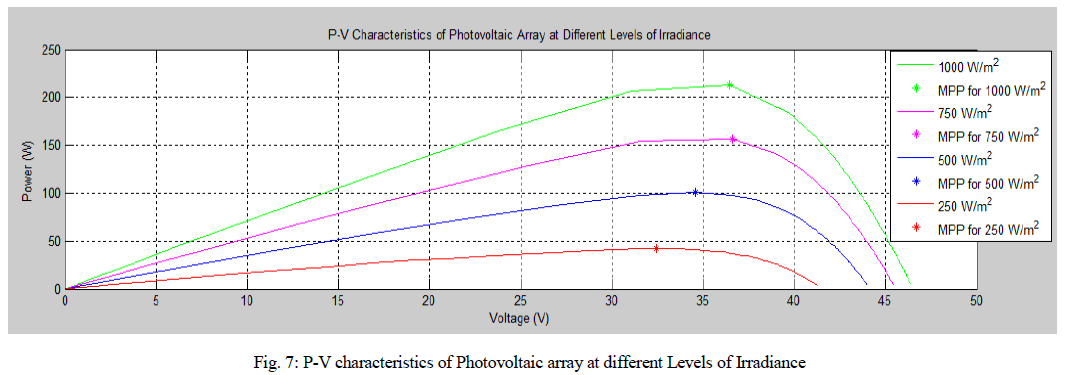 |
| The above shown Fig. 6 and Fig. 7 represent I-V characteristics and P-V characteristics of Photovoltaic array respectively, at different levels of irradiance. In Fig.7 value of maximum power point increases with increment in irradiance level so it states that output power of Photovoltaic array is directly proportional to irradiance level. Rather than irradiance level all other parameters are as mentioned in Appendix. |
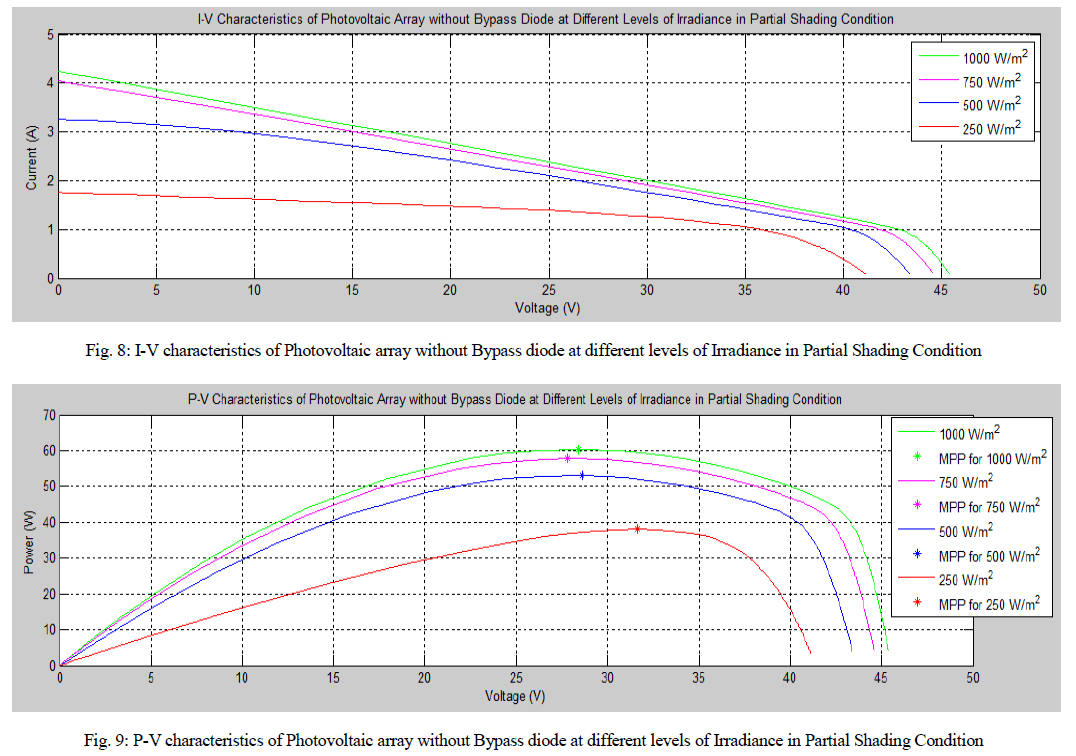 |
| Fig. 8 and Fig. 9 represent I-V characteristics and P-V characteristics of Photovoltaic array respectively, under partial shading condition without using bypass diode. Comparison of maximum power point of Fig.7 and Fig.9 states that two partial shaded photovoltaic modules decrease total output of Photovoltaic array by 3 times approximately. Rather than irradiance level all other parameters are as mentioned in Appendix. This condition is checked by using Bypass diode and results are as follow in Fig. 10 and Fig. 11. |
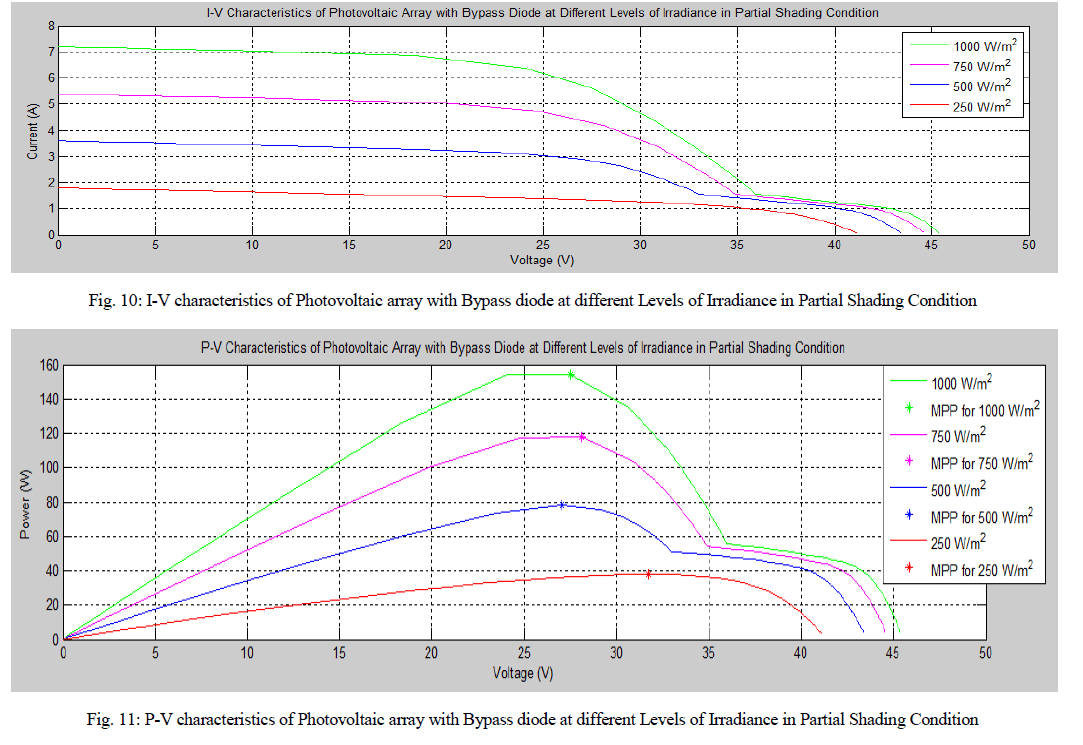 |
| Fig.10 and Fig.11 represent I-V characteristics and P-V characteristics of Photovoltaic array respectively, under partial shading condition by using bypass diode. Comparison of maximum power point of Fig. 9 and Fig. 11 states that the effect of partial shading condition can be decreased sufficiently with the help of Bypass diode. Rather than irradiance level all other parameters are as mentioned in Appendix. |
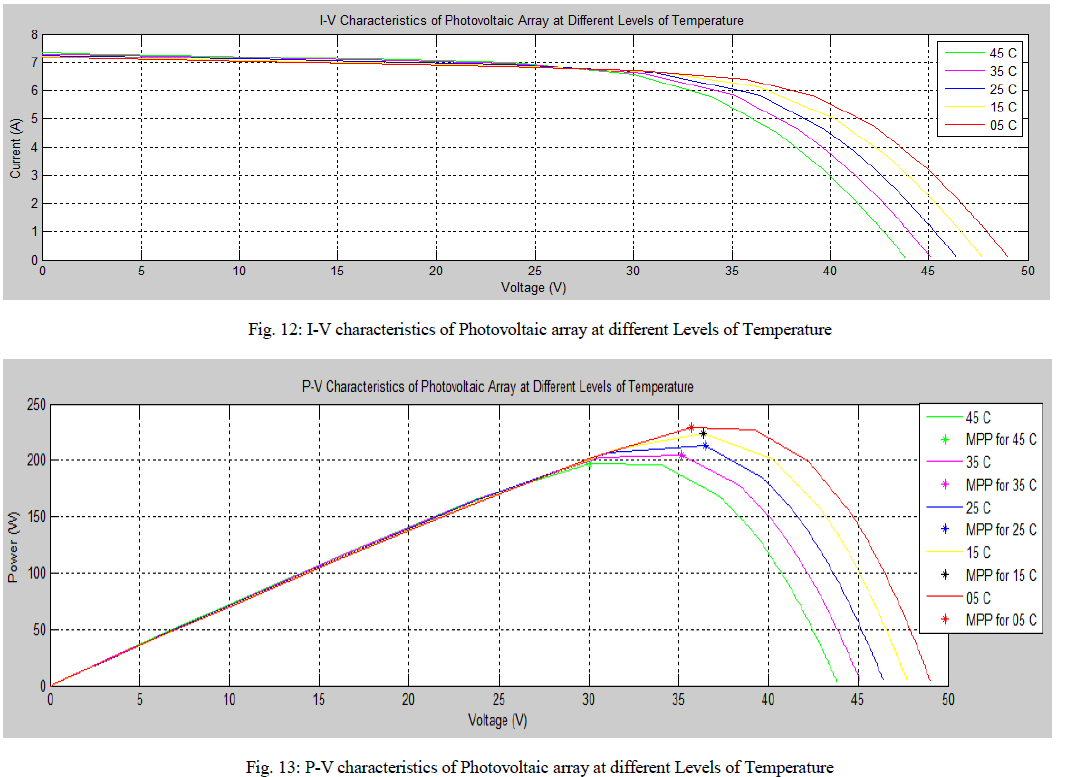 |
| Fig.12 and Fig.13 represent I-V characteristics and P-V characteristics of Photovoltaic array respectively, at different levels of temperature. In Fig.13 value of maximum power point decreases by increment in Temperature level so it states that output power of Photovoltaic array is inversely proportional to temperature level. Rather than temperature level all other parameters are as mentioned in Appendix. |
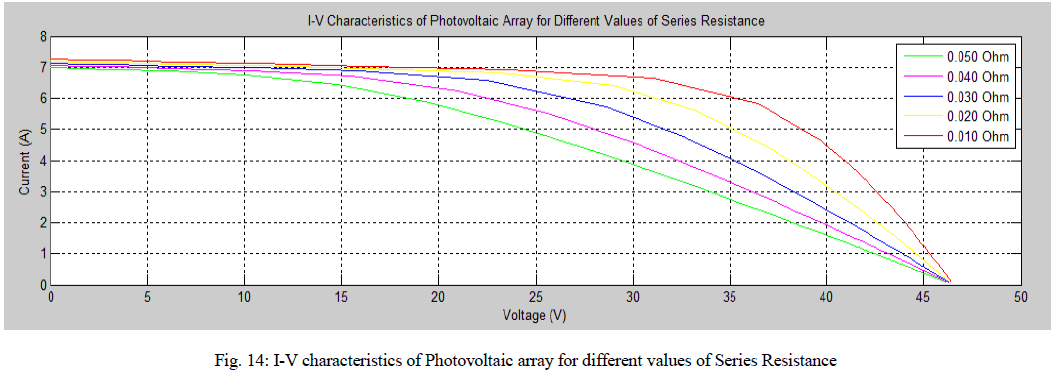 |
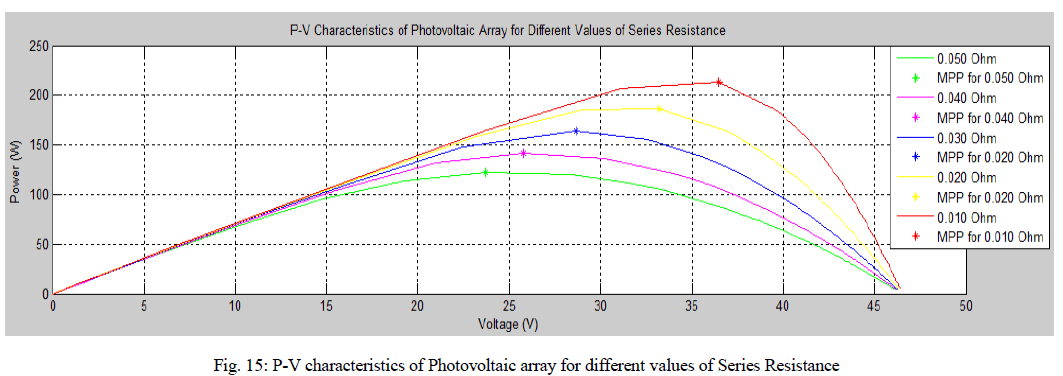 |
| Fig. 14 and Fig. 15 represent I-V characteristics and P-V characteristics of Photovoltaic array respectively, at different values of series resistance. In Fig. 15 value of maximum power point decreases sufficiently with small increment in value of series resistance so it states that output power of Photovoltaic array can be increased by decreasing value of series resistance. Rather than series resistance all other parameters are as mentioned in Appendix. |
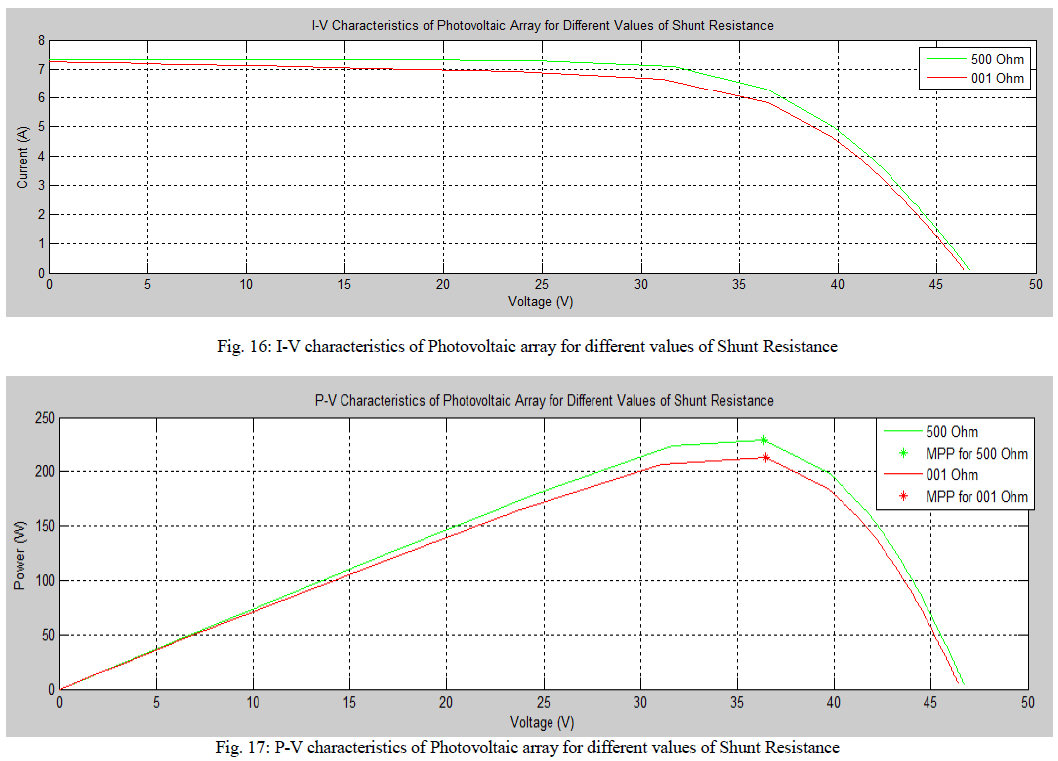 |
| Fig. 16 and Fig.17 represent I-V characteristics and P-V characteristics of Photovoltaic array respectively, at different values of shunt resistance. In Fig. 17 value of maximum power point increases slightly with large increment in value of shunt resistance so it states that output power of Photovoltaic array can be increased in some amount by large increment in value of shunt resistance. Rather than shunt resistance all other parameters are as mentioned in Appendix. |
VIII. CONCLUSION |
| This paper presents an in-depth Photovoltaic array characteristics including concept of Bypass diode with help of MATLAB/SIMULINK. This paper describes effect of change in environmental and physical parameters on characteristics of Photovoltaic array. If the environmental data of any particular area is counted in this system then the resultant graphs would give an idea about the performance of Photovoltaic array if it will be installed at the particular area. To create practical model of Photovoltaic array for studying Photovoltaic array characteristics under various parameters is quite costly and complex process, so this work has been economically and simply done through simulation in MATLAB/ SIMULINK. |
APPENDIX |
| Rs (Series resistance) = 0.010 Ohm, Rsh (Shunt resistance) = 1 Ohm, Temperature = 25âÃÂð C, Irradiance = 1000 W/m2. |
References |
|